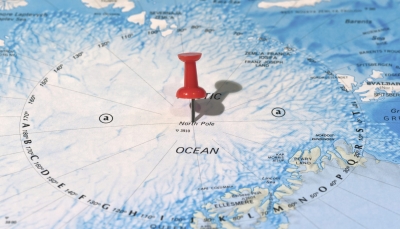
|
In geographical terms, the North Pole is the northernmost point on Earth’s axis of rotation. It is located in the Arctic, on the drifting, two to three metres thick ice that covers the waters of the ocean here. The warmest the North Pole gets is 0°C. Usually, though, the temperature is a bitterly cold sub-zero. In summer, the North Pole is bathed in the constant daylight, but the winter is a long, continuous dark night. |
The North Pole is the northernmost point on Earth. It is the precise point of the intersection of the Earth’s axis and the Earth’s surface.
From the North Pole, all directions are south. Its latitude is 90 degrees north, and all lines of longitude meet there (as well as at the South Pole, on the opposite end of the Earth). Polaris, the current North Star, sits almost motionless in the sky above the pole, making it an excellent fixed point to use in celestial navigation in the Northern Hemisphere.
The North Pole sits in the middle of the Arctic Ocean, on water that is almost always covered with ice. The ice is about 2-3 meters (6-10 feet) thick. The depth of the ocean at the North Pole is more than 4,000 meters (13,123 feet).
The Canadian territory of Nunavut lies closest to the North Pole. Greenland, the world’s largest island and an independent country within the Kingdom of Denmark, is also close to the pole.
The North Pole is much warmer than the South Pole. This is because sits at a lower elevation (sea level) and is located in the middle of an ocean, which is warmer than the ice-covered continent of Antarctica. But it’s not exactly beach weather. In the summer, the warmest time of year, the temperature is right at the freezing point: 0 degrees Celsius (32 degrees Fahrenheit.)
Because the Earth rotates on a tilted axis as it revolves around the sun, sunlight is experienced in extremes at the poles. In fact, the North Pole experiences only one sunrise (at the March equinox) and one sunset (at the September equinox) every year. From the North Pole, the sun is always above the horizon in the summer and below the horizon in the winter. This means the region experiences up to 24 hours of sunlight in the summer and 24 hours of darkness in the winter.
Credit: National Geographic
Picture credit: Google




